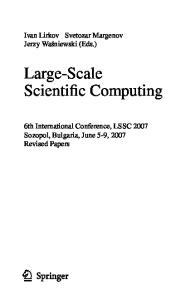Review about the Effect of He on the Microstructure of Spent Nuclear Fuel in a Repository
- PDF / 326,826 Bytes
- 10 Pages / 432 x 648 pts Page_size
- 8 Downloads / 323 Views
Review about the Effect of He on the Microstructure of Spent Nuclear Fuel in a Repository C. Ferry1, J. Radwan 2, H. Palancher 3 1 CEA, DEN, Service of fuel cycle technology development, BP 17171, 30207 Bagnols-sur-Cèze Cedex, France 2 CEA, DEN, Service for the studies of the radionuclides behavior, BP11, F-91191 Gif-sur-Yvette Cedex, France 3 CEA, DEN, Service of fuel studies and simulation, 13108 Saint Paul-Lez-Durance, France ABSTRACT Helium is produced in spent nuclear fuel by D-decays of actinides. After 10,000 years, the concentration of He accumulated in UO2 spent fuel is about 0.23 at.%. For direct disposal of spent nuclear fuel, consequences of helium build-up on the fuel matrix microstructure must be evaluated since it can modify the radionuclide release when water comes into contact with the spent fuel surface, after breaching of the disposal canister. An operational model has been proposed in order to evaluate the effect of helium on the microstructure of spent fuel in a repository. Based on conservative assumptions and different scenarios of bubble population, the calculated helium critical concentration, that could lead to a partial loss of integrity of the spent fuel pellet, is 0.37 at.%. However, observations on He-implanted UO2, D-doped UO2 pellets and natural analogues evidence a macroscopic damage only for He concentrations, which are more than one order of magnitude higher. INTRODUCTION Under geological disposal, water will contact the spent fuel surface after a long confinement period that can last 10,000 years. After the contact with water, the release of radionuclide (RN) is composed of two terms: a rapid release of radioactivity which consists of radionuclides located in the zones of the spent fuel rod without any capacity of confinement at the time of water arrival, and a slow release of radioactivity governed by the pellet dissolution. Hence, the release of RN will depend on the microstructure of the spent fuel pellet after about 10,000 years of evolution in a closed canister, induced by residual temperature and radioactivity. The main unknown today regards the effect of He on the microstructure of the pellet. Indeed a large amount of He is produced by the decay of actinides in the spent fuel (Table I). An operational model was proposed in order to evaluate the consequences of He on the spent fuel pellet microstructure [1]. In the model, the scenarios considered that all He atoms are trapped in pre-existing fission gas bubbles (Xe), or form new He bubbles in the spent fuel grains (presence of cavities and Schottky defects after irradiation). The bubble pressure, calculated for a 10,000 years production of He, was then compared to a critical bubble pressure, which leads to grain or grain-boundary rupture. The main uncertainties of the model are bounded to the choice of the equation of state of Xe and He at the high density of gas, and of the rupture criteria.
4147 Downloaded from https://www.cambridge.org/core. University of Texas Libraries, on 30 Aug 2017 at 15:13:40, subject to the Cambri
Data Loading...











